Archives
SHANGRILA SHAKEN
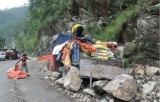 Next dawn, the orchestra took a different tune. Seasons seemed to take a u-turn. Rain fell as if it was the height of the monsoons. Rivers swelled. North Sikkim was hit badly. Loose soil gave way and landslips and mudslips posed obstacles to the Army which had already begun rescue operations in the quake ravaged district. Roads had caved in at numerous places across the state, yet the Panchayats and area legislators toured their respective areas to assess the damage caused by the devastating tremor.
Soon, NGOs and government aid started pouring in. Brave hearted members of NGOs trekked to over 10 villages in Dzongu swept away by the landslides, preceding the quake. Equally brave villagers trekked for over 10 hours to deliver the news of the quake damage at the north district headquarters at Mangan.
Next dawn, the orchestra took a different tune. Seasons seemed to take a u-turn. Rain fell as if it was the height of the monsoons. Rivers swelled. North Sikkim was hit badly. Loose soil gave way and landslips and mudslips posed obstacles to the Army which had already begun rescue operations in the quake ravaged district. Roads had caved in at numerous places across the state, yet the Panchayats and area legislators toured their respective areas to assess the damage caused by the devastating tremor.
Soon, NGOs and government aid started pouring in. Brave hearted members of NGOs trekked to over 10 villages in Dzongu swept away by the landslides, preceding the quake. Equally brave villagers trekked for over 10 hours to deliver the news of the quake damage at the north district headquarters at Mangan.
The rain following the tremor was a challenge for the Army and the National Disaster Response Force (NDRF) personnel already struggling in the hostile terrain. Thousands of villagers, workers and a few tourists remained stranded in the upper reaches of the Himalayas.
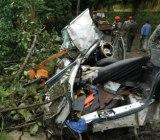 As of now, Army, Border Roads Organization and General Reserve Engineering Force personnel have managed to connect Mangan to Gangtok and Singtam. GREF teams have also been constructing the road between Tung and Chungthang, which has been badly damaged. After completing about three kilometers of the ravaged stretch, the team will rebuild roads up to Lachung on one side and Lachen on the other.
As of now, Army, Border Roads Organization and General Reserve Engineering Force personnel have managed to connect Mangan to Gangtok and Singtam. GREF teams have also been constructing the road between Tung and Chungthang, which has been badly damaged. After completing about three kilometers of the ravaged stretch, the team will rebuild roads up to Lachung on one side and Lachen on the other.
Ten teams of NDRF consisting of 419 personnel along with necessary search and rescue equipment were deployed in Sikkim. Teams stationed at Lachung and Chungthang area of Sikkim are still carrying out rescue and relief operations. The Ministry of Health, Government of India had deployed a medical team comprising 19 doctors which continues to provide medical help. The State Government has opened a total of 85 relief camps. A five-member team of experts from NIMHANS, Bangalore is also in North Sikkim to provide psycho-social care.
As far as relief supplies are concerned, approximately 11,000 food packets have been air dropped so far in the northern part of north district as of September 26th. A total of 1500 food packets were airdropped and a total of 22 sorties were carried out by helicopters on September 25th.
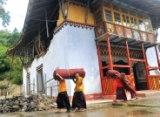 Seven days after the killer quake, the death toll (official figure) of the September 18th earthquake stood tall at 77 as no reports have come in of new casualties discovered or recovered from any part of the state. As per these latest figures, 59 lives have been lost in North Sikkim, 13 in East, South Sikkim-01 and West Sikkim 4.
Seven days after the killer quake, the death toll (official figure) of the September 18th earthquake stood tall at 77 as no reports have come in of new casualties discovered or recovered from any part of the state. As per these latest figures, 59 lives have been lost in North Sikkim, 13 in East, South Sikkim-01 and West Sikkim 4.
In North Sikkim, Mangan, Lachen and Lachung have recorded 13 casualties, 1 in Domang, 2 in Lingdong, 2 in Saffo, Upper Dzongu, 4 in Toong, 8 in Sophok (Adit-V), 12 in Chungthang, 11 in Salem-Pakyel and 7 in Bey, Dzongu. As of Sept 27th, the Chief Minister of Sikkim has already distributed ex gratia and compensation amounting to Rs1.72 crores in East District, Rs 61.1 lakhs in West, Rs 1.07 crores in north and Rs1.03 crores in south district. While the death compensation is Rs 5 lakh, Rs 50,000 was given for serious injuries and Rs 25,000 for minor ones. Similar compensation, Chamling said would be given to non Sikkimese labourers, who died or sustained injury in the quake. “We are not discriminating between victims on the basis of whether he or she is a Sikkimese. They had died while working for Sikkim’s development,” said the CM, who has urged the Sikkimese not to celebrate this year’s Dushera and Diwali.
As per the tentative details compiled by the State Government, 14994 houses have been fully damaged, 17788 partially damaged, 1582 mildly damaged and 5327 houses have been severely damaged in all four districts.
A total amount of Rs 12.51 crore has already been provided by the State Government till date to the various departments and the district of the state for the relief operations. The patients; government spokesperson IPR Secretary KS Topgay says, are also being referred outside the state for further treatment. The State Government has pegged the damage estimate at Rs 1 lakh crores.
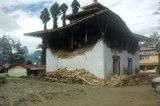
On September 25th, the State Government formed a six-member expert group to ascertain the stability of the land at Chungthang and Lachung. The expert committee, headed by retired Principal Director and geologist, Tshering Tashi, will prepare a report of the land stability and submit it to the Government, Topgay said. The committee has UD&HD Additional Chief Engineer, Devika Sharma Chettri, Seismologist Dr Amita Singhal from IIT Roorkee, Geo Technical Engineers Dr DK Maheswari and Dr Yogendra Singh from IIT Roorkee as members. The committee, it is informed, was formed in response to people’s fears about the stability of the North Sikkim towns. These fears, sparked by rumours and misinformation have reached near panic levels and a study by experts was hence commissioned.
On Sept 27th, a high level team headed by Shambhu Singh, Jt. Secretary, Ministry of Home Affairs reached Sikkim to oversee the relief and restoration work in the state and for the assessment of the damage caused by the earthquake.
Heritage structures fall to nature’s wrath
| As per the tentative details compiled by the State Government, 14994 houses have been fully damaged, 17788 partially damaged, 1582 mildly damaged and 5327 houses have been severely damaged in all four districts. |
The Buddhist monasteries throughout the remote mountains of Sikkim, the repositories of the architecture and culture of Sikkim have been severely damaged by the earthquake.
Sikkim’s most priceless artifacts – packed in 18 odd boxes – quietly hidden in remote Tholung monastery in North Sikkim, may have survived foreign invaders for over two centuries but not the earthquake that rattled Sikkim. The weak walls of the ancient monastery have broken down exposing the boxes to the rain, but only for the lock and seal of the state ecclesiastical department. Relics, belonging to the Gyalwa Lhabtsun Chhenpo, one of the three wise monks from Tibet, who is known to have met at Yuksam and laid the foundation of Dzogchen Buddhism in Sikkim, are opened and inventoried every three years during a ceremony called Kamsel. Like Tholung, the old monasteries – Drubdi, Tashiding, Pemayangtse, Enchey, etc have suffered equal damage.
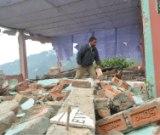 It may be a fortunate escape for the monks living in the century and a half year old Ringhim monastery in Mangan, whose walls of the prayer room have completely collapsed. Since it was a Sunday, monks had concluded their afternoon prayers at 5: 30 pm and not as in weekdays at 6 pm. “Had the prayer meeting continued till 6 pm as on weekdays, the monks could have been trapped inside as we could witness walls of the temple crumble down, the Principal of Ringhim Sheda Acharya Pema Dorji said. The monastery houses five senior monks and 55 students. It was constructed in 1852 and renovated in 1913.
It may be a fortunate escape for the monks living in the century and a half year old Ringhim monastery in Mangan, whose walls of the prayer room have completely collapsed. Since it was a Sunday, monks had concluded their afternoon prayers at 5: 30 pm and not as in weekdays at 6 pm. “Had the prayer meeting continued till 6 pm as on weekdays, the monks could have been trapped inside as we could witness walls of the temple crumble down, the Principal of Ringhim Sheda Acharya Pema Dorji said. The monastery houses five senior monks and 55 students. It was constructed in 1852 and renovated in 1913.
Chief Minister Pawan Chamling, it may be recalled, had visited the monastery on September 24th and assured immediate reconstruction and directed the area MLA to begin the process forthwith. Mr. Chamling also inspected the damage sustained by the premier Pemayangtse monastery in Pelling. He suggested that the monastery’s head monk should submit a report to the State Government and promised to rebuild the monastery to its original structure. “We will rebuild Pemagyangtse monastery to its earlier state. We will also re-construct the damaged stupas around the monastery,” Chamling said. He advised the head monk to keep the documents and other items of the monastery safe.
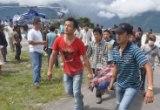 The famed Rumtek Monastery, 24 kms from Gangtok has also sustained cracks on columns and beams that support the building where monks spend their night. They fear that another tremor could bring the building down. Cracks have also developed in the main monastery and the Karma Shri Nalanda Institute, a part of the monastery. Senior monks fear that water may seep into those cracks and weaken the foundation of the building, where priceless artifacts and statues are enshrined. Much like these, a number of Buddhist shrines including Drubdi, Tashiding, Enchey, Phodong and Labrang Monasteries, Hindu temples, churches and stupas and statues of saints built across the state have also been damaged.
The famed Rumtek Monastery, 24 kms from Gangtok has also sustained cracks on columns and beams that support the building where monks spend their night. They fear that another tremor could bring the building down. Cracks have also developed in the main monastery and the Karma Shri Nalanda Institute, a part of the monastery. Senior monks fear that water may seep into those cracks and weaken the foundation of the building, where priceless artifacts and statues are enshrined. Much like these, a number of Buddhist shrines including Drubdi, Tashiding, Enchey, Phodong and Labrang Monasteries, Hindu temples, churches and stupas and statues of saints built across the state have also been damaged.
Schools and offices damaged.
Nearly 430 government schools have suffered major damage. Of them, 54 schools have totally or partially collapsed, according to a preliminary report.
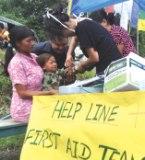 After taking stock of the widespread damage that educational institutions have suffered in the quake, the State HRDD Secretary CS Rao has also announced that all schools across Sikkim will reopen on October 10th after Dushera vacations. Rao said the schools would have to take extra classes in winter to make up for the loss. There are around 1.18 lakh students in the government schools and 24,000 in the 325 private institutions. It was also informed that the school heads will be available during this break to consult with the local panchayats and school managing committees to make alternative arrangement so that classes can start from October 10th. The Chief Minister has given `50 lakh as immediate relief for restoration of the school buildings, the Secretary said.
After taking stock of the widespread damage that educational institutions have suffered in the quake, the State HRDD Secretary CS Rao has also announced that all schools across Sikkim will reopen on October 10th after Dushera vacations. Rao said the schools would have to take extra classes in winter to make up for the loss. There are around 1.18 lakh students in the government schools and 24,000 in the 325 private institutions. It was also informed that the school heads will be available during this break to consult with the local panchayats and school managing committees to make alternative arrangement so that classes can start from October 10th. The Chief Minister has given `50 lakh as immediate relief for restoration of the school buildings, the Secretary said.
Following the damage suffered by the Tashiling Secretariat, five departments including the CM’s office housed in the complex have been shifted to new locations. Similar damage has occurred in Government Press building, Police Headquarters, hospital buildings and government buildings in all four districts.
CM reacts to hydel-quake link
| As far as relief supplies are concerned, approximately 11,000 food packets have been air dropped so far in the northern part of north district as of Sept 26th. A total of 1500 food packets were airdropped and a total of 22 sorties were carried out by helicopters on September 25th. |
With North Sikkim having to bear the brunt of the earthquake, coupled with “no sign of government personnel” in remotes villages, five days after the quake that ravaged the district, residents have vented their anger on the Chief Minister, blaming the mega power projects in the state for Sunday’s 6.8 earthquake.
The CM responded to the allegations saying that hydel projects had not triggered the earthquake which was a natural calamity. To allay fears, he cited the example of Canada and Switzerland, and claimed that these countries though dotted with hydel projects were safe. “If the power projects are the reason for earthquakes then these two countries would have been devastated much earlier,” he said.
“It has been 10 years since our government initiated power projects in Sikkim. Earthquakes of such magnitude did occur in Sikkim earlier but at that time there was not even electricity, let alone hydel projects. This is standing evidence that blaming hydel power projects for the earthquake is false,” Chamling said while distributing ex gratia to the 400 earthquake victims of East Sikkim at Chintan Bhavan, Gangtok on September 25th.
Sikkim will have 31 hydel projects along the river Teesta by 2015 and they are expected to generate `1,500 crore annually. Cautioning people not to get swayed by circulation of SMSes about another immediate impending quake triggered by hydel power projects, the CM said he has not initiated power projects to trigger earthquakes but to provide a perennial source of revenue for Sikkim and its development and to remove poverty. The CM has also been bothered by the mass exodus of labourers from power plants after the quake. This, the Chief Minister said will lead to a delay of one year in the completion of projects and Sikkim will lose Rs 500 crore.
Sign of hope
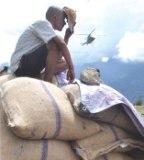 The Sikkim CM has said the state will be back to normalcy in a month. “Sikkim is one of the few states in India which has been building and promoting itself as an eco-friendly destination. The state will definitely stress more on quake proof mechanism as well. Though, earthquakes are something which can not be altogether mitigated, the Sikkimese people are determined not to let a quake overwhelm them and their visitors,” Chamling had said.
The Sikkim CM has said the state will be back to normalcy in a month. “Sikkim is one of the few states in India which has been building and promoting itself as an eco-friendly destination. The state will definitely stress more on quake proof mechanism as well. Though, earthquakes are something which can not be altogether mitigated, the Sikkimese people are determined not to let a quake overwhelm them and their visitors,” Chamling had said.
Members of Travel Agents Association of Sikkim (TAAS) inform that West Sikkim, known to draw a large number of tourists each year, is not as badly affected by the quake. “Most of the famous trekking trails located in West Sikkim have suffered only minor damage and will be restored before the season kicks off next month,” said a member of TAAS. Beginning October, hordes of foreigners trek to the famed Dzongri-Goecha-La in West Sikkim every year and tour operators say they have trekkers this year too.

